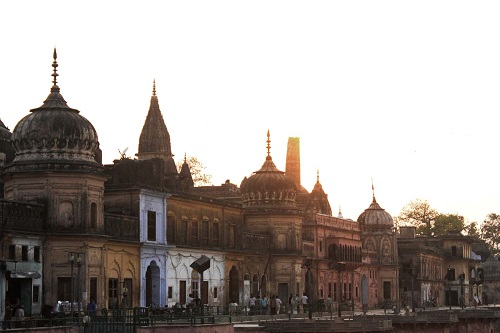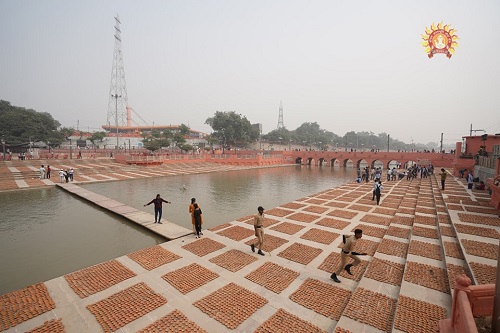In the heart of Ayodhya, the city that echoes ancient tales and timeless spirituality, stands the monumental Ayodhya Ram Mandir, also called Ram Janmabhoomi temple. This sacred structure, dedicated to Lord Ram, has a rich and storied background, marked by significant events that have captured the attention and devotion of millions.
Let’s embark on a journey to explore the Ayodhya Ram Mandir, from its inception to the present day.

The History of Ram Janmabhoomi Temple
The Ram Mandir history can be traced back to the longstanding historical and religious significance of Ayodhya itself. Ayodhya, the birthplace of Lord Ram, holds a unique place in Hindu mythology and culture. The city is mentioned in ancient scriptures and epics, including the Ramayana, where the life and adventures of Lord Ram unfold. The desire to build a grand temple at the birthplace of Lord Ram has been a longstanding dream for many devotees.
Ram Mandir-Babri Masjid dispute
The Ram Mandir-Babri Masjid dispute, a longstanding socio-religious conflict in Ayodhya, India, centered around a disputed site where a mosque, the Babri Masjid, stood. In 1992, the situation escalated when a Hindu nationalist mob demolished the mosque, claiming it was built on the birthplace of Lord Ram. This act led to communal tensions and widespread violence across the country.
The dispute’s roots trace back to the 16th century when the Mughal emperor Babur constructed the Babri Masjid. In the 1980s, demands for the mosque’s removal gained momentum, leading to heightened tensions. The legal battle intensified as Hindu and Muslim groups contested ownership claims.
The turning point came in 2019 when the Indian Supreme Court delivered a historic verdict, granting the disputed land to Hindus for the construction of a Ram Temple. The court acknowledged the illegal demolition of the mosque but emphasized the importance of restoring peace.
The resolution sparked diverse reactions, reflecting the complex interplay of religious, historical, and political sentiments in India. The dispute remains emblematic of the challenges in managing religious diversity and communal harmony in the country.
Stone-Laying Ceremony
The turning point in the quest to build the Ayodhya Ram Mandir came with the foundation stone-laying ceremony. This momentous occasion, held on a spiritually charged day, marked the beginning of the temple’s physical manifestation. The ceremony witnessed the participation of religious leaders, political figures, and countless devotees who gathered to witness the initiation of this divine endeavor.
Area and Capacity
Shri Ram Janmbhumi area is quite big, about 2.7 acres, covering 54,700 square feet. The whole complex will be even larger, spreading over nearly 70 acres, and it’s designed to welcome around a million devotees at once.
Ayodhya Mandir: Estimated Cost and Funding
Building the Ayodhya Ram Mandir is expected to cost INR 1,100 crores. Here’s where the money is coming from:
- People’s Donations: About 70% of the funds are coming from generous donations by people who want to see the temple built.
- Help from Rich People and Groups: Rich individuals and organizations are playing a big part too, contributing around 20% of the money needed.
- Government Support: The government is also helping out, covering about 10% of the total cost through different initiatives and grants.
Ayodhya Ram Mandir Construction
- Building Material
Every inch of the Ayodhya Ram Mandir is crafted with precision and devotion, using carefully chosen building materials. The architects and builders have meticulously selected stones, metals, and other materials that not only withstand the test of time but also resonate with the spiritual essence of the temple. The construction materials echo the commitment to creating a timeless masterpiece that transcends generations.
- Builders
Behind the scenes of the construction of Ram Mandir are skilled artisans and builders whose hands shape the divine vision into reality. These craftsmen, guided by a sense of duty and devotion, pour their skills and passion into every detail. The builders, chosen for their expertise, work in unison to ensure that every facet of the temple reflects the divine aura it is meant to embody.
Ram Mandir Temple’s Interiors
The interior is adorned with intricately carved sculptures and reliefs, depicting scenes from the Ramayana and showcasing the life and teachings of Lord Ram.
- Divine Motifs: The sacred Ayodhya Ram Mandir construction involves divine motifs inspired by Hindu mythology that are meticulously incorporated, adding layers of spiritual significance to every nook and corner.
- Precious Materials: The interior is embellished with precious materials such as marble, gold leafing, and gemstones, symbolizing the opulence and grandeur befitting a temple of such significance.
- Devotional Spaces: Dedicated spaces for meditation and prayer are strategically placed, allowing devotees to immerse themselves in a tranquil and spiritually charged atmosphere.
- Central Sanctum: The heart of the temple houses the central sanctum where the main deity, Lord Ram, resides. The sanctum is designed with utmost reverence, creating a focal point for devotees to direct their prayers and devotion.
Temple’s Doors and Windows
The doors and windows of the Ayodhya Ram Mandir are not merely physical entry points; they symbolize the gateways to spiritual realms. Crafted with precision and adorned with artistic brilliance, these portals add to the grandeur of the temple. The intricate designs tell stories of devotion, and the windows allow divine light to illuminate the sacred space within.
- Entrance Doors: The main entrance doors, crafted from solid teakwood, stand as towering symbols of strength and devotion. Adorned with intricate carvings of divine symbols and scenes from the Ramayana, they set the tone for the spiritual journey within.
- Door Dimensions: Each entrance door measures 18 feet in height and 9 feet in width, creating a majestic portal that captures the attention of every visitor.
- Windows of Devotion: Stained glass windows, strategically placed throughout the temple, depict various episodes from the life of Lord Ram. The play of coloured light adds a mystical ambience, inviting contemplation and reflection.
- Symbolic Window Designs: The window designs are not just aesthetic; they carry deep symbolic significance, representing aspects of divinity, righteousness, and the eternal journey of the soul.
- Durability and Craftsmanship: The doors and windows of the temple are made with durability in mind. This is to ensure that they withstand the test of time while maintaining their artistic brilliance. Skilled artisans have poured their expertise into every detail, creating not just functional elements but true works of art.
Opening Date of Ayodhya Ram Mandir
The leader of the Rashtriya Swayamsevak Sangh (RSS), Mohan Bhagwat, revealed that the Ayodhya Ram Temple is planned to open on January 24, 2024.
Temple opening timing: In the morning will be 7:00 AM to 11:00 AM and 2:00 PM to 6:00 PM.
The Darshan Timings will remain consistent throughout all seasons, including summer and winter. The Sri Ram Janmabhoomi Teerth Kshetra Trust plans to extend a formal invitation to Prime Minister Modi for the consecration event, during which Lord Ram’s idol will be installed in the inner sanctuary of the temple.
The temple trust has decided to conduct a 10-day ceremony for the pran pratishtha (consecration) of Lord Ram, commencing the process of consecrating the Ram Mandir on January 14, coinciding with Makar Sankranti.

Ram Mandir Bhumi Pujan
The Ram Mandir Bhumi Pujan on August 5, 2020, was a very special and happy day in Ayodhya, India. It was a big step toward building the Ram Mandir at the place where Lord Ram was born. People from all around came together, including leaders and millions of devotees, to celebrate this important moment.
During the Bhumi Pujan, the foundation of the temple was blessed in a ceremony that marked the start of building. Prime Minister Narendra Modi placed the first brick, and there were prayers and rituals led by priests with traditional chants and rituals.
This event was not just about building a temple; it was also about ending many years of disagreements about the land in Ayodhya. The Bhumi Pujan was a time to show India’s respect for different religions and come together in unity.
The construction of the Ram Mandir is like a dream coming true for many, and the Bhumi Pujan was a special day that will be remembered for a long time. It symbolizes faith, strength, and the rich cultural history of India.
Number of Pilgrims to Ayodhya Ram Mandir
The Ayodhya Ram Mandir 2024 is a place of worship and a pilgrimage site, which will attract millions of devotees each year. The number of pilgrims visiting this sacred abode is expected to rise significantly, drawing people from diverse backgrounds and cultures. The pilgrimage to Ayodhya is not merely a physical journey but a soulful quest for spiritual enlightenment and divine connection.
Ayodhya Sri Rama Temple, a divine abode, is not just a physical structure; it is a spiritual journey that unites millions in their quest for the divine. As the temple is close to its completion, the world eagerly awaits the moment when its doors will open, inviting all to experience the spirituality that resides within its sacred walls.

